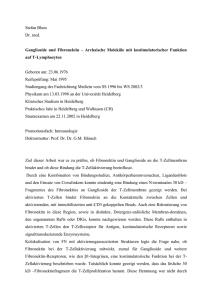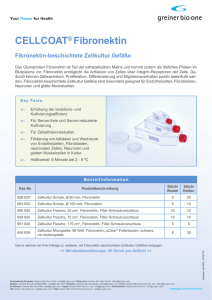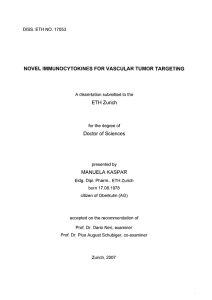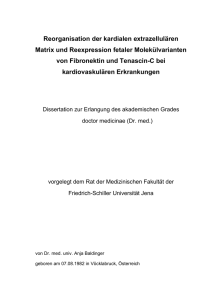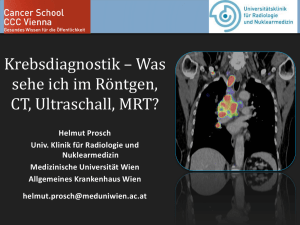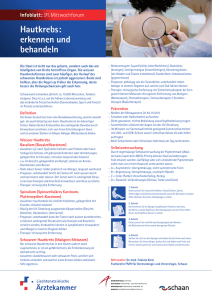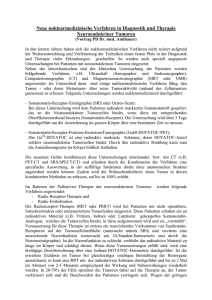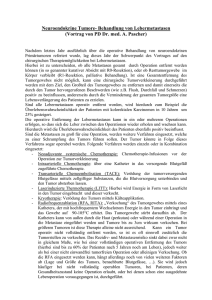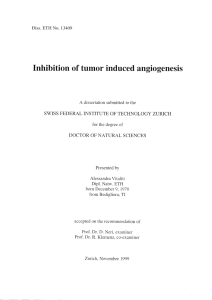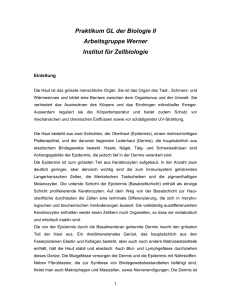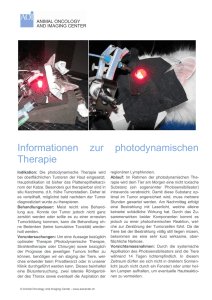Translationale Medizin Translational Medicine
Werbung
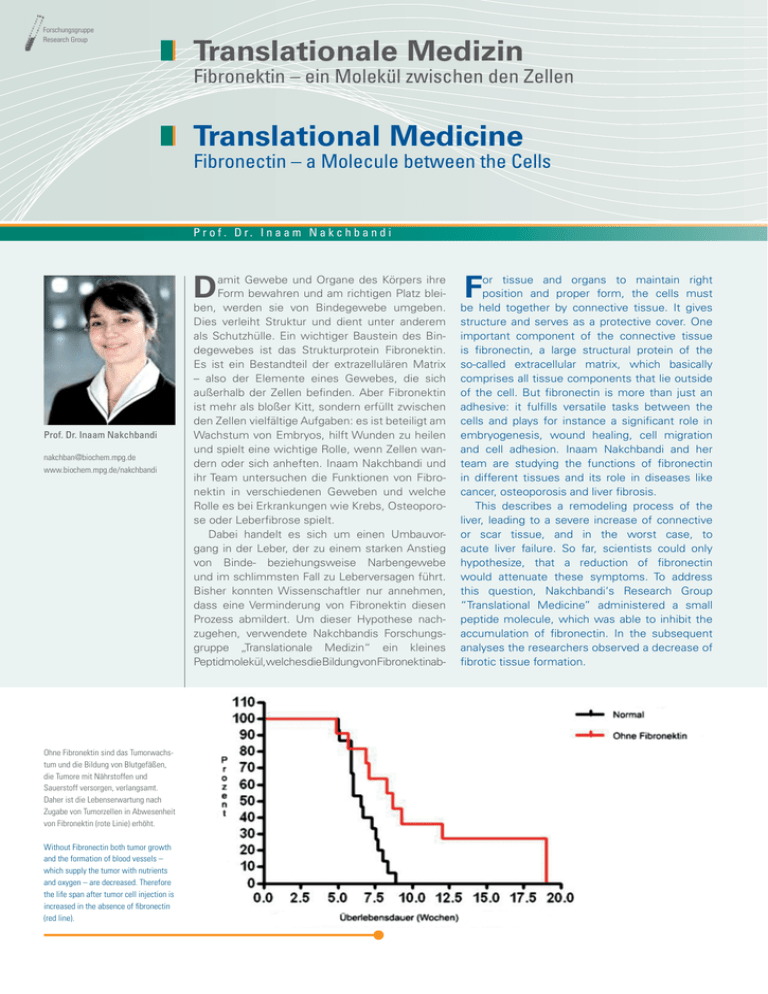
Forschungsgruppe Research Group Translationale Medizin Fibronektin – ein Molekül zwischen den Zellen Translational Medicine Fibronectin – a Molecule between the Cells P r o f . D r. I n a a m N a k c h b a n d i D Prof. Dr. Inaam Nakchbandi [email protected] www.biochem.mpg.de/nakchbandi Ohne Fibronektin sind das Tumorwachstum und die Bildung von Blutgefäßen, die Tumore mit Nährstoffen und Sauerstoff versorgen, verlangsamt. Daher ist die Lebenserwartung nach Zugabe von Tumorzellen in Abwesenheit von Fibronektin (rote Linie) erhöht. Without Fibronectin both tumor growth and the formation of blood vessels – which supply the tumor with nutrients and oxygen – are decreased. Therefore the life span after tumor cell injection is increased in the absence of fibronectin (red line). amit Gewebe und Organe des Körpers ihre Form bewahren und am richtigen Platz bleiben, werden sie von Bindegewebe umgeben. Dies verleiht Struktur und dient unter anderem als Schutzhülle. Ein wichtiger Baustein des Bindegewebes ist das Strukturprotein Fibronektin. Es ist ein Bestandteil der extrazellulären Matrix – also der Elemente eines Gewebes, die sich außerhalb der Zellen befinden. Aber Fibronektin ist mehr als bloßer Kitt, sondern erfüllt zwischen den Zellen vielfältige Aufgaben: es ist beteiligt am Wachstum von Embryos, hilft Wunden zu heilen und spielt eine wichtige Rolle, wenn Zellen wandern oder sich anheften. Inaam Nakchbandi und ihr Team untersuchen die Funktionen von Fibronektin in verschiedenen Geweben und welche Rolle es bei Erkrankungen wie Krebs, Osteoporose oder Leberfibrose spielt. Dabei handelt es sich um einen Umbauvorgang in der Leber, der zu einem starken Anstieg von Binde- beziehungsweise Narbengewebe und im schlimmsten Fall zu Leberversagen führt. Bisher konnten Wissenschaftler nur annehmen, dass eine Verminderung von Fibronektin diesen Prozess abmildert. Um dieser Hypothese nachzugehen, verwendete Nakchbandis Forschungsgruppe „Translationale Medizin“ ein kleines Peptidmolekül,welchesdieBildungvonFibronektinab- F or tissue and organs to maintain right position and proper form, the cells must be held together by connective tissue. It gives structure and serves as a protective cover. One important component of the connective tissue is fibronectin, a large structural protein of the so-called extracellular matrix, which basically comprises all tissue components that lie outside of the cell. But fibronectin is more than just an adhesive: it fulfills versatile tasks between the cells and plays for instance a significant role in embryogenesis, wound healing, cell migration and cell adhesion. Inaam Nakchbandi and her team are studying the functions of fibronectin in different tissues and its role in diseases like cancer, osteoporosis and liver fibrosis. This describes a remodeling process of the liver, leading to a severe increase of connective or scar tissue, and in the worst case, to acute liver failure. So far, scientists could only hypothesize, that a reduction of fibronectin would attenuate these symptoms. To address this question, Nakchbandi‘s Research Group “Translational Medicine” administered a small peptide molecule, which was able to inhibit the accumulation of fibronectin. In the subsequent analyses the researchers observed a decrease of fibrotic tissue formation. Häufen Zellen (Kerne in blau) Fibronektin an (rot, Bild links), kann das unter anderem bei der Krankheit Leberfibrose eine Rolle spielen. Ein kleines Peptid kann die Bildung von Fibronektinfibrillen verhindern (Bild rechts). In der Folge können die Forscher eine verbesserte Leberfunktion feststellen. lagerungen unterbindet. In der Folge konnten die Forscher beobachten, dass sich tatsächlich weniger fibrotisches Gewebe bildete. Auch in der Krebsforschung konnte Nakchbandis Forschungsgruppe Ergebnisse beisteuern, um die Rolle von Fibronektin zu erforschen und aufzuklären. Denn laut den Wissenschaftlern hilft Fibronektin den Tumoren, sich im Körper auszubreiten, da es an der Entstehung von neuen Blutgefäßen beteiligt ist. Diese versorgen die Krebszellen zum einen mit zusätzlichen Nährstoffen und ermöglichen ihnen darüber hinaus den Zugang zum Blutkreislauf – quasi der Autobahn des menschlichen Körpers. Die Wissenschaftler wiesen nach, dass weniger Fibronektin im Blut auch zu weniger Fibronektin im Krebsgewebe führte und die Tumoren langsamer wuchsen. Wie angenommen verringerte sich die Bildung neuer Blutgefäße durch geringere Mengen Fibronektin. Zudem zeigten Krebspatienten mit wenig Fibronektin eine wesentlich bessere Prognose. Diese Ergebnisse könnten möglicherweise in Zukunft helfen, neue Therapieansätze zu entwickeln. By elucidating the role of fibronectin, Nakchbandi‘s group could also gain new insights into the mechanisms of cancer. According to the scientists, fibronectin is an important factor with regards to tumor dissemination, since it is implicated in the formation of new blood vessels. These are not only essential for the supply of the tumor with nutrients but also enable tumor cells to enter blood circulation – quasi the highway of the human body. The scientists could prove that low fibronectin concentrations in the blood of cancer patients were associated with reduced concentrations in the respective tumors, which consequently were growing more slowly. As hypothesized, the formation of new blood vessels was impaired by the low levels of fibronectin. Moreover, cancer patients with little fibronectin showed a much better prognosis. These results could potentially be helpful for the development of new therapeutic directions in the future. Die Forschungsgruppe „Translationale Medizin“ von Inaam Nakchbandi ist ein Tandemprojekt der Max-Planck-Gesellschaft und der Universität Heidelberg. Kooperationspartner innerhalb der MaxPlanck-Gesellschaft ist die Abteilung „Molekulare Medizin“ des MPI für Biochemie. Ziel der Kooperation ist es, patientenorientierte klinische Forschung und Grundlagenforschung zu kombinieren. The Research Group “Translational Medicine” of Inaam Nakchbandi is a tandem project of the Max Planck Society and the University of Heidelberg. The cooperation partner within the Max Planck Society is the Research Department of “Molecular Medicine” at the MPI of Biochemistry. The aim of the cooperation is to combine patientoriented clinical and basic research. Prof. Dr. Inaam Nakchbandi 1991 MD at the University of Damascus, Syria 1993 – 1996 Residency in Internal Medicine, Abington Memorial Hospital, USA 1996 Fellowship, then associate research scientist at the Yale University School of Medicine, New Haven, USA 2000 – 2004 Physician at the University of Heidelberg, Germany 2003 Habilitation in Internal Medicine, University of Heidelberg, Germany 2004 Staff Scientist at the MPI of Biochemistry, Martinsried Since 2005 Head of the Research Group “Translational Medicine“ at the MPI of Biochemistry, Martinsried Since 2010 apl. Professorship, University of Heidelberg, Germany When cells (nuclei in blue) accumulate fibronectin (red, left panel), this may have major implications for diseases like liver fibrosis. A small peptide is able to prevent fibronectin assembly (right panel). In the subsequent analyses the researchers observe improved liver function. Selected Publications Altrock E, Sens C, Kawelke N, Vasel M, Dooley S and Nakchbandi IA (2014). ”Inhibition of fibronectin deposition improves experimental liver fibrosis” J Hepatol 62, 625-33. von Au A, Vasel M, Kraft S, Hackl N, Sens C, Marx A, Stroebel P, Hennelotter J, Todenhöfer T, Stenzl A, Schott S, Sinn HP, Wetterwald A, Bermejo JL, Cecchini MG and Nakchbandi IA (2013). ”Circulating fibronectin controls tumor growth” Neoplasia 15, 925-38. Kawelke N, Vasel M, Sens C, von Au A, Dooley S and Nakchbandi IA (2011). ”Fibronectin protects from excessive liver fibrosis by modulating the availability of and responsiveness of stellate cells to active TGF-β” PLoS One 6, e28181. 54 | 55
